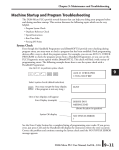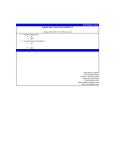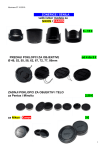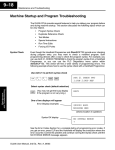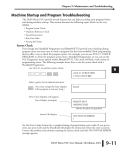Download User Manual - Galil Motion Control
Transcript
Ladder Interface Software Manual Version 1.0 beta 01/09 Galil's Ladder Interface Software is a software tool for the RIO-471x0 compact PLC. The software converts a relay Ladder Logic program into code for input into the RIO controller. Ladder Logic is often used by programmable logic controller (PLC) programmers to graphically input I/O logic. While direct RIO programming using Galil's two-letter text instructions allows for flexible coding, it is sometimes easier to determine the I/O logic visually with Ladder Logic. The Ladder Interface Software provides an easy-to-use graphical interface that allows object types for: contacts, coils, control relays, boxes (including timers, counters and data manipulation) and analog I/O. The software generates an RIO program from the specified objects in the flow diagram. In addition to generating optimized code, Galil's Ladder Interface Software automatically adds determinism to the RIO program. Steps to Running a Ladder Program 1. Open the Ladder Interface software and construct the ladder diagram using contacts, coils and boxes to create the machine logic. Save the Ladder Logic program (.lad) 2. When the ladder logic program is saved, a .dmc file will automatically be created in the same directory. It contains the Galil code for downloading onto the RIO471x0. 3. To download the .dmc code, you must first install the GalilTools software. To get scope capability, the full version is required, to just download and run a program the free "Lite" version will work 4. After GalilTools is installed, connect to the RIO-471x0 and open the .dmc file that was created. 5. Click the "Execute" button to download the .dmc file and execute the Ladder program. Anytime the Ladder Logic program is changed, the .lad file must be saved. Then a new .dmc file will be created and must be downloaded to the RIO via GalilTools in order for the changes to take effect. Copyright 2008 Galil Motion Control Inc. 270 Technology Way, Rocklin, CA 95765 USA. All rights reserved Memory Map Locations for RIO-471x0 Data RIO-471x0 Range Discrete digital inputs X0 - X15 Discrete digital outputs Y0 - Y15 Digital output register (16 bits) V0 Digital input register (16 bits) V100 Current timer value V200 - V207 Current counter value V250 - V257 Analog inputs V300 - V307 Analog outputs V400 - V407 User variable space (4.2 format) V500 - V524 Control relays C0 - C15 Timers T0 - T7 Counters CT0 - CT7 K constants No limit on total number.Galil 4.2 format (except where noted) AND - logical AND Symbol: Range: Description: AND's multiple elements on a rung. A logical AND compares two inputs. If they are both "TRUE", then the result is "TRUE", otherwise, the result is "FALSE". Type: Layout Example Ladder Program: GalilTools Scope Output: OR - logical OR Symbol: Range: Description: OR's multiple elements on a rung. The logical OR compares two inputs. If either or both are TRUE, then the result is TRUE, otherwise, the result is FALSE. Type: Layout Example Ladder Program: GalilTools Scope Output: STR - Store - Normally Open Symbol: Range: X0-X15 Y0-Y15 C0-C15 T0-T7 CT0-CT7 Description: A Normally Open contact evaluates true only when the input is active. In the example below, the digital output Y0 evaluates TRUE when the digital input X1 evaluates TRUE. When X1 evaluates FALSE, likewise Y0 evaluates FALSE. Type: Contact Example Ladder Program: GalilTools Scope Output: STRE - Equal to Symbol: Range: V0, V100 V200-V207 V250-V257 V300-V307 V400-V407 V500-V524 Knnnn Description: Equal to contact compares the two values and outputs TRUE when the values are equal, otherwise it is FALSE Type: Contact Example Ladder Program: GalilTools Scope Output: STRGE - Greater than or equal to Symbol: Range: V0, V100 V200-V207 V250-V257 V300-V307 V400-V407 V500-V524 Knnnn Description: Greater than or equal to contact evaluates TRUE if the first value is greater than or equal to the second value Type: Contact Example Ladder Program: GalilTools Scope Output: STRGT - Greater than Symbol: Range: V0, V100 V200-V207 V250-V257 V300-V307 V400-V407 V500-V524 Knnnn Description: Greater than contact evaluates TRUE if the first value is greater than the second value Type: Contact Example Ladder Program: GalilTools Scope Output: STRI - Store Immediate - Normally Open Symbol: Range: X0-X15 Y0-Y15 C0-C15 T0-T7 CT0-CT7 Description: This contact follows the same logic as the standard normally open contact except the input or memory location is read at the time the code executes instead of at the beginning of the scan Type: Contact Example Ladder Program: GalilTools Scope Output: STRLE - Less than or equal to Symbol: Range: V0, V100 V200-V207 V250-V257 V300-V307 V400-V407 V500-V524 Knnnn Description: Less than or equal to contact evaluates TRUE if the first value is less than or equal to the second value Type: Contact Example Ladder Program: GalilTools Scope Output: STRLT - Less than Symbol: Range: V0, V100 V200-V207 V250-V257 V300-V307 V400-V407 V500-V524 Knnnn Description: Less than contact evaluates TRUE if the first value is less than the second value Type: Contact Example Ladder Program: GalilTools Scope Output: STRN - Store Not - Normally Closed Symbol: Range: X0-X15 Y0-Y15 C0-C15 T0-T7 CT0-CT7 Description: A Normally Closed contact is the logical inversion (or NOT) of a normally open contact. The normally closed contact evaluates true only when the input is NOT active. In the example below, when the digital input X1 evaluates FALSE, the digital output Y0 evaluates TRUE. Likewise, when X1 evaluates TRUE, the output Y0 evaluates FALSE. Type: Contact Example Ladder Program: GalilTools Scope Output: STRNE - Not equal to Symbol: Range: V0, V100 V200-V207 V250-V257 V300-V307 V400-V407 V500-V524 Knnnn Description: Not equal to contact compares the two values and outputs TRUE when the values are not equal, otherwise it is FALSE Type: Contact Example Ladder Program: GalilTools Scope Output: STRNI - Store Immediate - Normally Closed Symbol: Range: X0-X15 Y0-Y15 C0-C15 T0-T7 CT0-CT7 Description: This contact follows the same logic as the standard normally closed contact except the input or memory location is read at the time the code executes instead of at the beginning of the scan Type: Contact Example Ladder Program: GalilTools Scope Output: END - Program End Symbol: Range: N/A Description: End of Ladder Program Type: Coil Example Ladder Program: GalilTools Scope Output: NOP - No operation Symbol: Range: N/A Description: No operation is performed Type: Coil OUT - Output Symbol: Range: Y0-Y15 C0-C15 Description: This outputs the current state of the rung (TRUE or FALSE) to an output bit or memory location. In the example below, the output Y0 follows the same logic states as the input X1. The memory range C0-C15 can also be used to trigger "Control Relays". These act like digital outputs but have no physical outputs associated with them. Type: Coil Example Ladder Program: GalilTools Scope Output: OUTI - Immediate output Symbol: Range: Y0-Y15 C0-C15 Description: Similar to the OUT instruction, this coil outputs the current state of the rung but instead of waiting until the end of the scan - it outputs the logic at the time the instruction is executed. Type: Coil Example Ladder Program: GalilTools Scope Output: PD - Positive differential output Symbol: Range: Y0-Y15 C0-C15 Description: This coil, upon a FALSE-TRUE transition, will turn TRUE for exactly one scan and then return FALSE. This is sometimes referred to as a "one-shot" coil. Type: Coil Example Ladder Program: GalilTools Scope Output: RST - Reset latching output Symbol: Range: Y0-Y15 C0-C15 Description: The RST coil resets a latching output or memory location. Once the location is reset, it is not necessary for the input to stay on. Type: Coil Example Ladder Program: GalilTools Scope Output: SET - Latching output Symbol: Range: Y0-Y15 C0-C15 Description: This coil, upon a FALSE-TRUE transition, will turn TRUE and remain TRUE regardless of following transitions. The SET will only set FALSE upon a FALSE-TRUE transition of the RST coil. Type: Coil Example Ladder Program: GalilTools Scope Output: SKPR - Skip Rungs Reset Symbol: Range: K0-K3 Description: The SKPS and SKPR must be used as a pair. When the SKPS is TRUE, it will allow interpretation of all rungs up to the following SKPR. When the SKPS is FALSE, all rungs up to the following SKPR will not be interpreted. Note that while the rungs are not interpreted while SKPS is FALSE, these rungs still count to towards the scan time to insure deterministic timing. The argument K0 is reserved for future use. Type: Coil Example Ladder Program: GalilTools Scope Output: SKPS - Skip Rungs Set Symbol: Range: K0-K3 Description: The SKPS and SKPR must be used as a pair. When the SKPS is TRUE, it will allow interpretation of all rungs up to the following SKPR. When the SKPS is FALSE, all rungs up to the following SKPR will not be interpreted. Note that while the rungs are not interpreted while SKPS is FALSE, these rungs still count to towards the scan time to insure deterministic timing. The argument K0 is reserved for future use. Type: Coil Example Ladder Program: GalilTools Scope Output: STOP - Program stop Symbol: Range: N/A Description: Halts execution of Ladder program. The default argument of K0 halts the main thread. Use Kx where x is the thread number to halt execution of other threads. Type: Coil Example Ladder Program: GalilTools Scope Output: GALIL Cmd - Galil command box Symbol: Range: Cmd is any valid Galil command Description: Sends valid Galil command to controller. The command will be sent on every scan that the rung evaluates TRUE therefore the user should take care in what command is being output. If an MG command is used, this will send messages out the communications port and could slow down scan times (especially when using RS-232). A PD (Positive Differential) output should be used in conjunction with this box to only have the command run one time. Type: Boxes (Special) Example Ladder Program: GalilTools Scope Output: - Analog input Symbol: Range: V300-V307 Description: Read analog input at a specified variable location. Analog inputs should be accessed on the RIO using V300-V307. In the example below, a sine wave is coming in on the analog input 6 and two comparative contacts are used to set digital outputs Y0 and Y2 when the voltage goes below the constant K2 (2Volts) or above the constant K3 (3Volts). Type: Boxes (Data manipulation and math functions) Example Ladder Program: GalilTools Scope Output: - Analog output Symbol: Range: V400-V407 Description: Written at specific variable location. Type: Boxes (Data manipulation and math functions) Example Ladder Program: GalilTools Scope Output: ADD - Add to accumulator Symbol: Description: Add V variable location or K constant to accumulator value Type: Boxes (Data manipulation and math functions) Example Ladder Program: GalilTools Scope Output: Range: V0, V100 V200-V207 V250-V257 V300-V307 V400-V407 V500-V524 K0 - Kmax AND - And accumulator Symbol: Description: AND accumulator value with variable location Type: Boxes (Data manipulation and math functions) Range: V0, V100 V200-V207 V250-V257 V300-V307 V400-V407 V500-V524 K0 - Kmax DEC - Decrement variable value Symbol: Range: V0, V100 V200-V207 V250-V257 V300-V307 V400-V407 V500-V524 Description: This decrements the value of the V location by 1 Type: Boxes (Data manipulation and math functions) DIV - Divide from accumulator Symbol: Description: Divide accumulator value by V variable location or K constant Type: Boxes (Data manipulation and math functions) Example Ladder Program: GalilTools Scope Output: Range: V0, V100 V200-V207 V250-V257 V300-V307 V400-V407 V500-V524 K0 - Kmax INC - Increment variable value Symbol: Range: V0, V100 V200-V207 V250-V257 V300-V307 V400-V407 V500-V524 Description: This increments the value of the V location by 1 Type: Boxes (Data manipulation and math functions) INV - Inverse accumulator Symbol: Range: N/A Description: Inverse accumulator (1's complement) Type: Boxes (Data manipulation and math functions) LD - Load accumulator Symbol: Description: Loads a value into the accumulator Type: Boxes (Data manipulation and math functions) Example Ladder Program: GalilTools Scope Output: Range: V0, V100 V200-V207 V250-V257 V300 - V307 V400-V407 V500-V524 K0 - Kmax MUL - Multiply from accumulator Symbol: Range: V0, V100 V200-V207 V250-V257 V300-V307 V400-V407 V500-V524 K0 - Kmax Description: Multiply accumulator value by V variable location or K constant Type: Boxes (Data manipulation and math functions) Example Ladder Program: GalilTools Scope Output: OR - Or accumulator Symbol: Description: Or accumulator value with variable location Type: Boxes (Data manipulation and math functions) Range: V0, V100 V200-V207 V250-V257 V300-V307 V400-V407 V500-V524 K0 - Kmax OUT - Output accumulator Symbol: Range: V0, V100 V200-V207 V250-V257 V300-V307 V400-V407 V500-V524 Description: Outputs the current value of the accumulator to the specified memory location Type: Boxes (Data manipulation and math functions) Example Ladder Program: GalilTools Scope Output: ROTL - Rotate accumulator left Symbol: Range: K1 - K16 Description: Rotate accumulator left by Knn bits Type: Boxes (Data manipulation and math functions) Example Ladder Program: GalilTools Scope Output: ROTR - Rotate accumulator right Symbol: Range: K1 - K16 Description: Rotate accumulator right by Knn bits Type: Boxes (Data manipulation and math functions) Example Ladder Program: GalilTools Scope Output: SHFL - Shift accumulator left Symbol: Range: K1 - K16 Description: Shift accumulator left by Knn bits Type: Boxes (Data manipulation and math functions) Example Ladder Program: GalilTools Scope Output: SHFR - Shift accumulator right Symbol: Range: K1 - K16 Description: Shift accumulator right by Knn bits Type: Boxes (Data manipulation and math functions) Example Ladder Program: GalilTools Scope Output: SUB - Subtract from accumulator Symbol: Range: V0, V100 V200-V207 V250-V257 V300-V307 V400-V407 V500-V524 K0 - Kmax Description: Subtract V variable location or K constant from accumulator value Type: Boxes (Data manipulation and math functions) Example Ladder Program: GalilTools Scope Output: XOR - Exclusive OR accumulator Symbol: Description: Exclusive OR evaluates true when inputs are different Type: Boxes (Data manipulation and math functions) Range: V0, V100 V200-V207 V250-V257 V300-V307 V400-V407 V500-V524 K0 - Kmax CTD - Down counter Symbol: Range: CT0-CT7 K0-Kmax Description: Upon a FALSE-TRUE transition of a rung, the down counter decrements it's internal counter by one. A preset value is assigned as Kn, where n is an integer value. When the current counter value is greater than the preset value, the counter done bit is set TRUE. Then the current counter value is less than the preset value, the counter done bit is set FALSE. Note: The CTD may only be used in conjunction with the CTU, and must be the rung directly following the CTU. The CTD and CTU will share the same counter number (ie. CT0) as well as preset value (Kn). Type: Boxes (Counters/Timers) CTU - Up counter Symbol: Range: CT0-CT7 K0-Kmax Description: Upon a FALSE-TRUE transition of a rung, the up counter increments it's internal counter by one. A preset value is assigned as Kn, where n is an integer value. When the current counter value exceeds the preset value, the counter done bit is set TRUE. The done bit and current count can be reset by the RES box. Type: Boxes (Counters/Timers) Example Ladder Program: GalilTools Scope Output: RES - Reset box Symbol: Range: V0 V200-V207 V250-V257 V400-V407 V500-V524 Description: The RES box is used to reset variable locations within the ladder code. It can be used to reset the current timer or counter value, or to reset a user variable location (V500-V524). If the RES box is to be used to reset the counter or timer value, it must be placed on the rung directly after the counter or timer it is to effect. Type: Boxes (Counters/Timers) Example Ladder Program: GalilTools Scope Output: RTO - Accumulating timer Symbol: Range: T0-T7 K0-Kmax Description: This timer operates similarly to the On-delay timer. Upon a rung evaluating as TRUE, the timer begins counting in msec. Upon the rung evaluating as FALSE, the timer stops counting, but is not zeroed. The time is retained. On the next rung TRUE condition, the counter continues counting, thereby measuring accumulated TRUE time of the rung. The preset Kn is set to a value in msec. When the accumulated time is greater than the preset value Kn, the done bit is set. Done bit and accumulated time can only be reset by using the RES box. Type: Boxes (Counters/Timers) Example Ladder Program: GalilTools Scope Output: TOF - Off delay timer Symbol: Range: T0-T7 K0-Kmax Description: The Off-delay timer, upon the rung evaluating as FALSE, will begin timing in msec. The timer will remain timing while the rung evaluates as FALSE. A preset value is assigned as Kn, where n is a time in msec. When the current timer value exceeds the preset value Kn AND the rung remains FALSE, the timer done bit Tn will set TRUE. When the rung evaluates as TRUE, the timer is held to 0 and the done bit is FALSE. Type: Boxes (Counters/Timers) Example Ladder Program: GalilTools Scope Output: TON - On delay timer Symbol: Range: T0-T7 K0-Kmax Description: The On-delay timer, upon the rung evaluating as TRUE, will begin timing in msec. The timer will remain timing while the rung evaluates as TRUE. A preset value is assigned as Kn, where n is a time in msec. When the current timer value exceeds the preset value Kn AND the rung remains TRUE, the timer done bit Tn will set TRUE. When the rung evaluates as FALSE, the timer is held to 0 and the done bit is FALSE. Type: Boxes (Counters/Timers) Example Ladder Program: GalilTools Scope Output:




































































